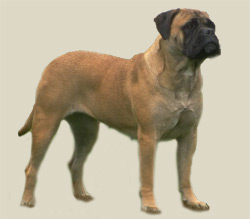
Country of Origin: Great Britain
Group: Pinscher and Schnauzer - Molossoid Breeds - Swiss Mountain and Cattle Dogs
Section: Molossoid breeds
Original Function: estate guardian
Todays Function: companion
Dimension Male: 63-69 cm
Dimension Female: 61-66 cm
Weight Male: 50-60 kg
Weight Female: 45-54 kg
Litter Size: 4-13 puppies, average 8
Life span: 8-10 years
Other Names: none
Colors: Fawn or brindle or red, each with black markings on the head.
Living: The bullmastiff doesn"t need a lot of space to be happy, so an apartment can be an ideal living spac
Recognized: CKC, FCI, AKC, KCGB, CKC, ANKC, NKC, NZKC, APRI, ACR
Description
The Bullmastiff is very powerfully built, but not cumbersome, with a broad wrinkled head and fairly short, square, dark muzzle about 1/3 the length of the whole head,. The nose is black with large nostrils. The dark hazel, medium-sized eyes should have an alert, intelligent expression. The v-shaped wide-set ears are pendant and dark colored. The teeth should meet in a level or slightly undershot bite. The short back is straight and level between the withers and the loin. The tapering tail is set high and reaches to the hocks. The short, slightly rough coat comes in brindle, fawn, or red, often with black markings on the head.
Temperament
The bullmastiff is gentle and quiet, a devoted companion and guardian. It is not easily roused, but once threatened it is fearless. It is stubborn and cannot easily be goaded into action against its will. Some can be aggressive toward strange dogs, but it is generally good with other household dogs and pets. It is good with children, but it may not be playful enough to satisfy some children. The bullmastiff needs a firm but loving home. It is not for fragile or timid owners.
Excercise
The bullmastiff is a big dog and needs daily exercise to stay in shape. Its needs are moderate, however, and can be met with walks on leash and short romps. It does not do well in hot, humid weather and generally should be kept as an indoor dog. It needs a soft bed and plenty of room to stretch out. It drools; some snore. Coat care is minimal.
Grooming
The short-haired, slightly rough coat is easy to groom. Comb and brush with a firm bristle brush, and shampoo only when necessary. There is little shedding with this breed. Check the feet regularly because they carry a lot of weight, and trim the nails.
Health
Major concerns: gastric torsion, CHD, elbow dysplasia
Minor concerns: entropion
Occasionally seen: PRA
Suggested tests: hip, elbow, eye,

